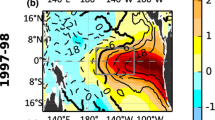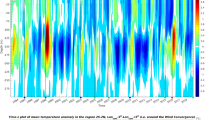Abstract
Extreme El Niño (e.g., 1983/1983 and 1997/1998) causes severe weather and climate impacts globally, but the associated dynamics is not fully understood. The present study shows that advection of mean temperature by anomalous eastward zonal current plays an important role in producing such extreme events especially during the early part of the developing period. While the climatological direction of the upper oceanic current in the equatorial Pacific is westward, at times the direction reverses. These eastward current events are well distinguished from the normal, westward conditions. The upper-layer zonal current in the equatorial Pacific is basically in geostrophic balance and forced by wind stress. However, in the case of the eastward zonal current events, persistent westerly winds are observed in the Western Pacific, and the current becomes synchronized with the westerly wind stress above. The advection of the mean temperature by the anomalous zonal current in the early developing period always precedes strong El Niño, though it does not significantly contribute to the growth of La Niña, neutral, and moderate El Niño; and is the major contributor of asymmetry in the early developing phase.










Similar content being viewed by others
References
An S-I (2004) Interdecadal changes in the El Nino–La Nina asymmetry. Geophys Res Lett 31(23):L23210. doi:10.1029/2004gl021699
An S-I (2009) A review of interdecadal changes in the nonlinearity of the El Niño-Southern Oscillation. Theor Appl Climatol 97(1):29–40. doi:10.1007/s00704-008-0071-z
An S-I, Choi J (2009) Seasonal locking of the ENSO asymmetry and its influence on the seasonal cycle of the tropical eastern Pacific sea surface temperature. Atmos Res 94(1):3–9
An S-I, Jin F-F (2004) Nonlinearity and asymmetry of ENSO. J Climate 17(12):2399–2412
Ashok K, Behera SK, Rao SA, Weng H, Yamagata T (2007) El Niño Modoki and its possible teleconnection. J Geophys Res 112 (C11):C11007. doi:10.1029/2006jc003798
Balmaseda MA, Vidard A, Anderson DLT (2008) The ECMWF ocean analysis system: ORA-S3. Mon Weather Rev 136(8):3018–3034. doi:10.1175/2008mwr2433.1
Barnett T, Hasselmann K (1979) Techniques of linear prediction, with application to oceanic and atmospheric fields in the tropical Pacific. Rev Geophys 17(5):949–968
Behringer DW, Ji M, Leetmaa A (1998) An improved coupled model for ENSO prediction and implications for ocean initialization. Part I: the ocean data assimilation system. Mon Weather Rev 126(4):1013–1021
Belamari S, Redelsperger J-L, Pontaud M (2003) Dynamic role of a westerly wind burst in triggering an equatorial Pacific warm event. J Climate 16(12):1869–1890. doi:10.1175/1520-0442(2003)016<1869:DROAWW>2.0.CO;2
Bjerknes J (1966) A possible response of the atmospheric Hadley circulation to equatorial anomalies of ocean temperature. Tellus 18(4):820–829
Bjerknes J (1969) Atmospheric teleconnections from the equatorial pacific. Mon Weather Rev 97(3):163–172
Carton JA, Giese BS (2008) A reanalysis of ocean climate using Simple Ocean Data Assimilation (SODA). Mon Weather Rev 136(8):2999–3017
Compo GP, Whitaker JS, Sardeshmukh PD, Matsui N, Allan RJ, Yin X, Gleason BE, Vose RS, Rutledge G, Bessemoulin P, Brönnimann S, Brunet M, Crouthamel RI, Grant AN, Groisman PY, Jones PD, Kruk MC, Kruger AC, Marshall GJ, Maugeri M, Mok HY, Nordli Ø, Ross TF, Trigo RM, Wang XL, Woodruff SD, Worley SJ (2011) The twentieth century reanalysis project. Q J R Meteor Soc 137(654):1–28. doi:10.1002/qj.776
Duan W, Xu H, Mu M (2008) Decisive role of nonlinear temperature advection in El Niño and La Niña amplitude asymmetry. J Geophys Res 113 (C1):C01014. doi:10.1029/2006jc003974
Fedorov AV, Philander SG (2001) A stability analysis of tropical ocean-atmosphere interactions: bridging measurements and theory for El Niño. J Climate 14(14):3086–3101
Frauen C, Dommenget D (2010) El Niño and La Niña amplitude asymmetry caused by atmospheric feedbacks. Geophys Res Lett 37:L18801
Grodsky SA, Carton JA (2001) Intense surface currents in the tropical Pacific during 1996–1998. J Geophys Res 106 (C8):16673–16684. doi:10.1029/2000jc000481
Hannachi A, Stephenson D, Sperber K (2003) Probability-based methods for quantifying nonlinearity in the ENSO. Clim Dyn 20(2–3):241–256. doi:10.1007/s00382-002-0263-7
Harrison DE, Chiodi AM (2009) Pre- and post-1997/98 westerly wind events and equatorial Pacific cold tongue warming. J Climate 22(3):568–581. doi:10.1175/2008JCLI2270.1
Harrison DE, Vecchi GA (1997) Westerly wind events in the tropical Pacific, 1986–95. J Climate 10(12):3131–3156. doi:10.1175/1520-0442(1997)010<3131:WWEITT>2.0.CO;2
Hayes SP, Mangum LJ, Picaut J, Sumi A, Takeuchi K (1991) TOGA-TAO: a moored array for real-time measurements in the tropical Pacific Ocean. Bull Am Meteorol Soc 72(3):339–347
Hoerling MP, Kumar A, Zhong M (1997) El Niño, La Niña, and the nonlinearity of their teleconnections. J Climate 10(8):1769–1786. doi:10.1175/1520-0442(1997)010<1769:enolna>2.0.co;2
Inoue M, O’Brien JJ (1984) A forecasting model for the onset of a major El Niño. Mon Weather Rev 112(11):2326–2337
Jin F-F (1997a) An equatorial ocean recharge paradigm for ENSO. Part I: conceptual model. J Atmos Sci 54(7):811–829
Jin F-F (1997b) An equatorial ocean recharge paradigm for ENSO. Part II: a stripped-down coupled model. J Atmos Sci 54 (7):830–847. doi:10.1175/1520-0469(1997)054<0830:AEORPF>2.0.CO;2
Jin F-F, An S-I (1999) Thermocline and zonal advective feedbacks within the equatorial ocean recharge oscillator model for ENSO. Geophys Res Lett 26(19):2989–2992. doi:10.1029/1999gl002297
Jin F-F, Neelin JD (1993a) Modes of interannual tropical ocean-atmosphere interaction-A unified view. Part I: numerical results. J Atmos Sci 50(21):3477–3503
Jin F-F, Neelin JD (1993b) Modes of interannual tropical ocean-atmosphere interaction-A unified view. Part III: analytical results in fully coupled cases. J Atmos Sci 50(21):3523–3540
Jin F-F, An S-I, Timmermann A, Zhao J (2003) Strong El Niño events and nonlinear dynamical heating. Geophys Res Lett 30(3):1120. doi:10.1029/2002gl016356
Jin F-F, Kim ST, Bejarano L (2006) A coupled-stability index for ENSO. Geophys Res Lett 33(23):L23708. doi:10.1029/2006gl027221
Kanamitsu M, Ebisuzaki W, Woollen J, Yang SK, Hnilo JJ, Fiorino M, Potter GL (2002) NCEP-DOE AMIP-II reanalysis (R-2). Bull Am Meteorol Soc 83(11):1631–1644
Kang I-S, Kug J-S (2002) El Nino and La Nina sea surface temperature anomalies: asymmetry characteristics associated with their wind stress anomalies. J Geophys Res 107 (D19):4372
Kao H-Y, Yu J-Y (2009) Contrasting Eastern-Pacific and Central-Pacific types of ENSO. J Climate 22(3):615–632. doi:10.1175/2008jcli2309.1
Keshavamurty RN (1982) Response of the atmosphere to sea surface temperature anomalies over the equatorial Pacific and the teleconnections of the Southern Oscillation. J Atmos Sci 39(6):1241–1259. doi:10.1175/1520-0469(1982)039<1241:ROTATS>2.0.CO;2
Kim W, Yeh S-W, Kim J-H, Kug J-S, Kwon M (2011) The unique 2009–2010 El Niño event: a fast phase transition of warm pool El Niño to La Niña. Geophys Res Lett 38:L15809. doi:10.1029/2011GL048521
Kug J-S, Jin F-F, An S-I (2009) Two types of El Niño events: cold tongue El Niño and warm pool El Niño. J Climate 22(6):1499–1515
Kutsuwada K, McPhaden MJ (2002) Intraseasonal variations in the upper equatorial Pacific Ocean prior to and during the 1997–98 El Niño. J Phys Oceanogr 32(4):1133–1149. doi:10.1175/1520-0485(2002)032<1133:ivitue>2.0.co;2
Larkin NK, Harrison DE (2005) Global seasonal temperature and precipitation anomalies during El Niño autumn and winter. Geophys Res Lett 32(16):L16705. doi:10.1029/2005gl022860
McPhaden MJ, Yu X (1999) Equatorial waves and the 1997–1998 El Niño. Geophys Res Lett 26(19):2961–2964. doi:10.1029/1999gl004901
McPhaden MJ, Busalacchi AJ, Cheney R, Donguy JR, Gage KS, Halpern D, Ji M, Julian P, Meyers G, Mitchum GT, Niiler PP, Picaut J, Reynolds RW, Smith N, Takeuchi K (1998) The tropical ocean-global atmosphere observing system: a decade of progress. J Geophys Res C Oceans 103 (C7):14169–14240
McPhaden MJ, Ando K, Bourles B, Freitag H, Lumpkin R, Masumoto Y, Murty V, Nobre P, Ravichandran M, Vialard J (2009a) The global tropical moored buoy array. Community White Paper for OceanObs, p 9
McPhaden MJ, Zhang X, Zhang X (2009b) Asymmetry in zonal phase propagation of ENSO sea surface temperature anomalies. Geophys Res Lett 36:L13703
Monahan AH, Dai A (2004) The spatial and temporal structure of ENSO nonlinearity. J Climate 17(15):3026–3036. doi:10.1175/1520-0442(2004)017<3026:tsatso>2.0.co;2
Neelin JD, Jin F-F (1993) Modes of interannual tropical ocean-atmosphere interaction-a unified view. Part II: analytical results in the weak-coupling limit. J Atmos Sci 50(2l):3504-3522
Neelin JD, Battisti DS, Hirst AC, Jin FF, Wakata Y, Yamagata T, Zebiak SE (1998) ENSO theory. J Geophys Res 103 (C7):14261–14214, 14290
Park J-Y, Kug J-S, Park J, Yeh S-W, Jang CJ (2011) Variability of chlorophyll associated with El Niño-Southern Oscillation and its possible biological feedback in the equatorial Pacific. J Geophys Res 116 (C10):C10001. doi:10.1029/2011JC007056
Philip S, van Oldenborgh GJ (2009) Significant atmospheric nonlinearities in the ENSO cycle. J Climate 22(14):4014–4028. doi:10.1175/2009jcli2716.1
Schneider EK, Huang B, Shukla J (1995) Ocean wave dynamics and El Nino. J Climate 8(10):2415–2439
Schopf PS, Burgman RJ (2006) A simple mechanism for ENSO residuals and asymmetry. J Climate 19(13):3167–3179
Smith TM, Reynolds RW, Peterson TC, Lawrimore J (2008) Improvements to NOAA’s historical merged land-ocean surface temperature analysis (1880–2006). J Climate 21(10):2283–2296
Su J, Zhang R, Li T, Rong X, Kug J-S, Hong C-C (2010) Causes of the El Niño and La Niña amplitude asymmetry in the equatorial Eastern Pacific. J Climate 23(3):605–617. doi:10.1175/2009jcli2894.1
Suarez MJ, Schopf PS (1988) A delayed action oscillator for ENSO. J Atmos Sci 45(21):3283–3287. doi:10.1175/1520-0469(1988)045<3283:ADAOFE>2.0.CO;2
Timmermann A, Jin F-F (2002) Phytoplankton influences on tropical climate. Geophys Res Lett 29(23):2104. doi:10.1029/2002GL015434
Timmermann A, Jin F-F, Abshagen J (2003) A nonlinear theory for El Niño bursting. J Atmos Sci 60(1):152–165. doi:10.1175/1520-0469(2003)060<0152:antfen>2.0.co;2
Tziperman E, Cane MA, Zebiak SE, Xue Y, Blumenthal B (1998) Locking of El Niño’s peak time to the end of the calendar year in the delayed oscillator picture of ENSO. J Climate 11(9):2191–2199. doi:10.1175/1520-0442(1998)011<2191:loenos>2.0.co;2
Uppala SM, Kållberg P, Simmons A, Andrae U, Bechtold V, Fiorino M, Gibson J, Haseler J, Hernandez A, Kelly G (2005) The ERA-40 re-analysis. Q J R Meteor Soc 131(612):2961–3012
Wang W, McPhaden MJ (2001) Surface layer temperature balance in the equatorial Pacific during the 1997–98 El Niño and 1998–99 La Niña. J Climate 14(16):3393–3407. doi:10.1175/1520-0442(2001)014<3393:sltbit>2.0.co;2
Wang C, Picaut J (2004) Understanding ENSO physics—a review. Earth Climate Ocean-Atmos Inter Geophys Monogr 147:21–48
White GH (1980) Skewness, kurtosis and extreme values of northern hemisphere geopotential heights. Mon Weather Rev 108(9):1446–1455. doi:10.1175/1520-0493(1980)108<1446:skaevo>2.0.co;2
Zebiak SE, Cane MA (1987) A model El Nino-Southern Oscillation. Mon Weather Rev 115(10):2262–2278
Acknowledgments
This work is supported by Australian climate change programme and Water for a Healthy Country Flagship. The authors would like to thank the anonymous reviewers and internal reviewers, Seon-Tae Kim and Simon Borlace.
Author information
Authors and Affiliations
Corresponding author
Rights and permissions
About this article
Cite this article
Kim, W., Cai, W. The importance of the eastward zonal current for generating extreme El Niño. Clim Dyn 42, 3005–3014 (2014). https://doi.org/10.1007/s00382-013-1792-y
Received:
Accepted:
Published:
Issue Date:
DOI: https://doi.org/10.1007/s00382-013-1792-y




